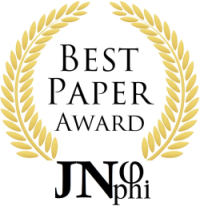Front Waves of Chemical Reactions and Travelling Waves of Neural Activity
Abstract
Travelling waves crossing the nervous networks at mesoscopic/macroscopic scales have been correlated with different brain functions, from long-term memory to visual stimuli. Here we investigate a feasible relationship between wave generation/propagation in recurrent nervous networks and a physical/chemical model, namely the Belousov–Zhabotinsky reaction (BZ). Since BZ’s nonlinear, chaotic chemical process generates concentric/intersecting waves that closely resemble the diffusive nonlinear/chaotic oscillatory patterns crossing the nervous tissue, we aimed to investigate whether wave propagation of brain oscillations could be described in terms of BZ features. We compared experimentally detected oscillations during the spontaneous activity of the brain with BZ-like concentric waves simulated by a recently introduced artificial network. The observed overlap and agreement between simulated and measured oscillatory patterns suggests that changes in cortical areas’ neural activity might be described in terms of a recognizable diffusion pattern. We describe biological plausibility, benefits and limits of our approach and discuss the relationship among BZ-like networks, Pandemonium-like architectures and the spontaneous activity of the brain.
Keywords:
central nervous system; chaos; chemical reaction; spontaneous activity; BOLD activity; nonlinear dynamics.Downloads
Metrics
References
Afraimovich V, Tristan I, Varona P, Rabinovich JM. Transient Dynamics in Complex Systems: Heteroclinic Sequences with Multidimensional Unstable Manifolds. Discontinuity, Nonlinearity and Complexity 2013; 2(1): 21-41.
Akam T, Kullmann DM. Oscillations and filtering networks support flexible routing of information. Neuron 2010; 67:308–320.
Beekman AJ, Nissinen J, Wu K, Liu K,Slager R-J, et al. Dual gauge field theory of quantum liquid crystals in two dimensions. Physics Reports 2017; 683:1-110.
Cincotti A, Maucher F, Evans D, Chapin BM, Horner K, et al. Threaded Rings that Swim in Excitable Media. Phys Rev Lett 2019; 123, 258102
Davis ZW, Muller L, Martinez-Trujillo J, Sejnowski T, Reynolds JH. Spontaneous travelling cortical waves gate perception in behaving primates. Nature 2020; 587:432–436.
Downloads
Published
How to Cite
License
Copyright (c) 2022 Arturo Tozzi, Yidi Zhang, Shan Guo, Mingzhu Sun, Lucio Mariniello, Xin Zhao

This work is licensed under a Creative Commons Attribution-NonCommercial-ShareAlike 4.0 International License.
Authors continue to hold copyright with no restrictions.














